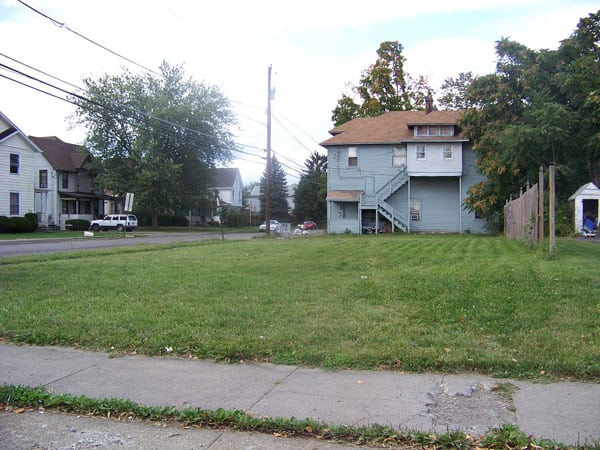
September 10, 2018; Next City
In 2012, Eltoreon Hawkins bought a house in the blighted Walnut Park neighborhood of St. Louis, Missouri, for $1000. He thought the empty lot next door was part of his property, and he took care of it. He discovered his mistake when he read the deed, but an alderman assured him that maintaining the property would pay off. Hawkins became the first individual to participate in the Mow to Own program. In 2014, the mayor himself handed Hawkins the title to the empty lot; for just $125, Hawkins earned the ownership of a plot of vacant land because he kept it mowed for the required two years.
In the latest fiscal year, 80 homeowners were successful in getting land title, joining Hawkins in the Mow to Own club. The now 25-year-old manager of a meal delivery nonprofit is currently working towards turning over the neighborhood, one lot at a time. He has bought two more homes close by for $2,500 and $3,500; one, he rehabbed to rent, and one he gave to his mother.
“My vision is to start on the block, in the neighborhood where I live,” he says. “I want to stabilize it. I see it as my chance to give back to my immediate community.”
The St. Louis Land Reutilization Authority (LRA) is the city’s land bank, which currently lists about 600 vacant lots in the same ward as Hawkins’s. They offer the homes for sale at an average price that ranges from $1000 to $3500.
Cities like St. Louis, along with others like Philadelphia, Cleveland, and Detroit, face dwindling populations in some neighborhoods, with empty houses and lots strewn with garbage. The condition has been named hypervacancy by author Alan Mallach in a 2018 report from the Lincoln Institute of Land Policy, “The Empty House Next Door.” The recession of 2008 compounded the problem, as homeowners walked away from mortgages that were “underwater.” For instance, in 2017 it was reported that 26 percent of Cleveland’s 160,000 residential parcels (with and without structures) were empty.
Sign up for our free newsletters
Subscribe to NPQ's newsletters to have our top stories delivered directly to your inbox.
By signing up, you agree to our privacy policy and terms of use, and to receive messages from NPQ and our partners.
“The earliest work that targeted vacant land was tied almost exclusively to addressing the nuisance and problems,” says Terry Schwarz, director of Kent State University’s Cleveland Urban Design Collaborative. “They centered on land stabilization and greening projects or reducing eyesore characteristics of vacant properties.” There’s been a change in thinking, however, says Schwarz. “Now, the new policies that have the most long-term impact are less about fixing nuisances or problems and instead seeing land for what it is: real estate. Cities now want to see what ways they have at their disposal to extract value out of their growing inventories of vacant properties.”
St. Louis is making a concerted effort to address its vacancies. In 1971, it became the first city to establish a land bank. The LRA owns about 11,500 properties, with 8,100 of them vacant. Mow to Own and similar “sidelot” programs are a minor part of the plan to flip the vacancies to occupied spaces of different types. The city saves anywhere from $1000 to $2400 annually on each property enrolled in Mow to Own.
Nonprofits in Philadelphia are partnering with local community groups in LandCare, a program started by the Pennsylvania Horticultural Society (PHS) a $24-million nonprofit founded in 1831. In 2003, they began their successful program to fence empty lots, mow the yards, and clean trash. A little more than a quarter of Philadelphia’s 40,000 vacant properties are now managed by LandCare, with $3 million from the city and $16 million from private funders. LandCare spends about $1,300 to fence, clean, and replant the lots. They’ve scaled up to surpass PHS’s ability to manage the program; LandCare has reached out to community groups, such as community development corporations and business improvement districts, as subcontractors, vetting and training them. The positive outcomes are measurable: LandCare’s immediate benefits are apparent, starting with a 20 percent jump in nearby home values. Mental and physical health have also felt the impact of the greened and cleaned lots. Their white rail fences have caught on, too.
Detroit Future City is a nonprofit that is working with the city and community groups to green up properties in blighted neighborhoods of Detroit. They have produced a manual to revitalize and rehab lots. They target specific projects to raise funds for rehabbing and stewardship of the land, succeeding with about 60 lots so far, keeping it on a smaller scale in order to include educating of the community’s residents.
At 70, eastern Detroit resident Jackie Grant has made it her mission to improve her neighborhood, where about 1,200 abandoned homes have been torn down in the last 10 years. With her son, she and her neighbors got a Future City grant, cleaned a vacant lot, put up a fence, and planted trees and flowers.
One person at a time—from Hawkins in St. Louis, to Grant in Detroit—mowing the lawn and planting trees works for the good of all.—Marian Conway













